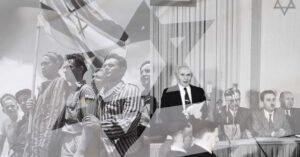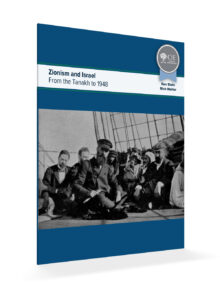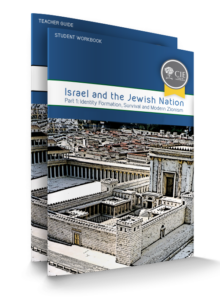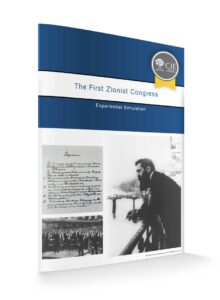Israel curriculum primarily focuses on Israel and not on Jewish studies or Jewish history. Of course, the context of modern Israel history or Israel studies evolves from the Jewish past. Here we are focusing on Zionism and Israel for formal and informal education settings. The following component elements are provided:
• Key curated essentials
• Self-learning, on-demand units
• Age-appropriate curriculum guides
• Teaching outlines and lesson plans
• Suggested terms, ideas and concepts
• Research bibliographies
• College syllabi
• Weekly Torah portion

Delve into the roots of Jewish peoplehood and the pivotal moments in Jewish history that led to the rebirth of Israel in 1948. Explore how precarious Diaspora life and outbursts of violent antisemitism catalyzed Jewish self-determination. Examine how Jewish leaders employed compromise, perseverance and adaptation in interactions with the Ottomans, British, and Arabs to overcome challenges, and so much more.

Explore the connections between the self-reliance, resilience, and democratic local self-governance Jews developed and nurtured in the Diaspora and the institutions and systems that define the complex parliamentary democracy of the State of Israel and the role of nongovernmental organizations.

Zionism and Israel: From the Tanakh to 1948 explores the foundations of the centrality of the Land of Israel to the Jewish people and how the relationship between the people and the land evolved over time. Activities and background information are provided to help learners explore the growth of the Jewish Diaspora, the evolving relationship between the people and the Land and the origins of the Zionist movement. Following the First Zionist Congress in 1897, Zionism and Israel: From the Tanakh to 1948 shifts to explore how the Basle Declaration and subsequent documents guided the movement’s actions towards its vision for a Jewish State. The material concludes with an exercise on Israel’s Declaration of Independence.

In ancient Israel, Tu B’Shvat was the day when farmers offered the first fruits of their trees in the form of a tithe or tax to the Temple after the trees had turned 4 years old.

“Zionist and Israeli Political Leadership: Idealism, Realism and Pragmatism” Ziv Rubinovitz, Undergraduate, Emory University, Spring 2015 This course discusses the political leadership of the State of Israel as an introduction into Israel’s political system. The…

E-book
Covering the foundations of Judaism and the history of the Jewish people, the unit starts with the ‘covenants’ and ends in 1897. It traces the Jewish connection to the land of Israel, in the land and in exile. It explains how and why Jews retained their traditions in the face of enormous challenges. It concludes with the birth of Zionism as one answer to Jewish insecurity.
- Suitable for learners 9th grade and up
- The first of four planned units covering Israel and the Jewish Nation
- 37-page teacher guide
- 78-page student workbook
- Covers the foundations of Judaism and Jewish people starting with the ‘covenants’
- Learn how and why the Jews retained their traditions in the face of enormous challenges
- Explore the connection to the land of Israel and the birth of Zionism

E-book
Travel back in time to August 29, 1897, when the First Zionist Congress was held in Basel, Switzerland. Experience the meeting from the inside, participating as the delegates from seventeen different nations! This guide includes an activity guide, a full list of all 200+ participants, biographies of 25 of the delegates and extensive background readings, including full translations of some of the speeches given at the congress.
- Suitable for learners 9th grade and up
- 72-page learners guide

“The Palestine Mandate: 1920-1948” Kenneth W. Stein, Introductory, Upper-Level Seminar, Emory University, Spring 2007 This junior/senior colloquium reviews the 30-year history before the creation of Israel in 1948. We try to answer the question “Why…







